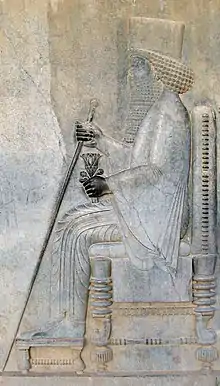Abrocomas
Abrocomas (Greek: Ἀβρόκoμας) was satrap of Syria for the Achaemenid king Artaxerxes II Mnemon.[2][3] He may also have been satrap of Paphlagonia, with its capital at Sinope, according to the reading of some of the coinage of Sinope: the Aramaic reading "ˈbrkmw" has been identified as the name rendered in Greek as "Abrocomas",[4] but this is not universally accepted.[1]

Abrocomas was sent with an army of 300,000 men to oppose Cyrus the Younger on his march into Upper Asia.[5] On Cyrus's arrival at Tarsus in 401 BC, Abrocomas was said to be on the Euphrates.[6] At Issus four hundred heavy-armed Greeks, who had deserted Abrocomas, joined Cyrus. Abrocomas did not defend the Syrian passes, as was expected, but marched to join the king. He burnt some boats to prevent Cyrus from crossing the Euphrates, but did not arrive in time for the battle of Cunaxa.[7]
In about 385, with Persian generals Pharnabazus and Tithraustes, Abrocomas unsuccessfully attempted to reconquer Egypt for the Persian Empire.[8]
Notes
- Frye, Richard Nelson (1984). The History of Ancient Iran. C.H.Beck. p. 115. ISBN 9783406093975.
- Bury, J. B. (2018). The Ancient World 401-330 BC. Perennial Press. p. 11. ISBN 9781531260279.
- Brownson, Carlson L. (Carleton Lewis) (1886). Xenophon;. Cambridge, Mass. : Harvard University Press. p. 39.
- Jacques, Duchesne Guillemin (1974). Acta iranica: collection fondée à l'occasion du 2500e anniversaire de la fondation de l'empire Perse par Cyrus le grand (in French). Bibliothèque Pahlavi. p. iv. ISBN 9789004039025.
- Smith, William (2005). A Dictionary of Greek and Roman biography and mythology. By various writers. Ed. by William Smith. Illustrated by numerous engravings on wood. p. 3.
- Brownson, Carlson L. (Carleton Lewis) (1886). Xenophon;. Cambridge, Mass. : Harvard University Press. p. 33.
- Xenophon, Anabasis, i. 3-4, 7; Suda, s.v. "Abrokamas"
- Isocrates, Panegyricus
References
- Smith, William (editor); Dictionary of Greek and Roman Biography and Mythology, "Abrocamas", Boston (1867)
 This article incorporates text from a publication now in the public domain: Smith, William, ed. (1870). "Abrocomas". Dictionary of Greek and Roman Biography and Mythology.
This article incorporates text from a publication now in the public domain: Smith, William, ed. (1870). "Abrocomas". Dictionary of Greek and Roman Biography and Mythology.
External links
- Abrocomas at the Encyclopædia Iranica
